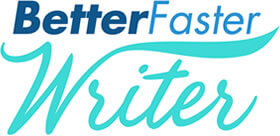Why do you write at work?
Your answer might be “I write at work because I have to use email,” or “I write at work because it’s part of my job” or something similar.
But is any of that really the reason why?
Nope. The real reason why you write at work is to inform, persuade or even convince someone, be that a coworker, boss, stakeholder, prospect, customer, vendor or someone else.

But to do any of that, your writing first has to get read. Because you can’t inform anyone if they don’t read what you wrote, can you? And how do you get your writing read? One way is to make sure it’s engaging.
How do you make it engaging? Write something you’d want to read. (Or as Ben Franklin once said, “…write something worth reading, or do something worth writing.”)
That’s sound advice, but maybe not helpful if you don’t know how. So here’s an easy way to make your writing engaging: use rhythm.
Writing with Rhythm
Writing can and should be engaging if you want it read. Because the fact is, as the writer, it’s your job to serve the reader, not the other way around. And that applies to both business writing and to marketing and sales writing too.
When you have the chance, add a little rhythm to your writing as you’ll see in the examples below. That bit of rhythm or sing song will make your writing more appealing (and therefore engaging).
How can you spot the right places for rhythm? Read your writing out loud. And you’ll know.
When you write for work, you should read everything you write out loud anyway. This helps you catch errors, but it also gives you a chance to hear how writing sounds…and find places to jazz things up.
Now you and I both know your readers, be they coworkers or customers, won’t necessarily read your email, letter or other content out loud using their voices. But guess what? They will in their minds.
Go back and read that last paragraph again. When you read the question “But guess what?,” did you mentally give the question a higher note at the end just as you would have while reading it out loud? That’s exactly what I’m talking about. Even when we aren’t reading out loud using our voices, our minds are reading “out loud.”
That’s why writing with rhythm makes your writing at (or for) work more engaging. Your reader will “hear” that bit of sing song.
And more engaging writing is writing that gets read, saving you time and effort while improving communications…or sales.
Proof of the Power of Rhythm
Don’t believe me? Compare these four ads below, all collected from real life. Read all four quietly and/or out loud. What do you notice about the fourth one that you don’t the other three?




Do you hear the difference? The fourth one has a sing song quality to it, a rhythm that the other three don’t but easily could. In fact, the first three are jarring to my ears.
Why does this matter? Because the rhythm is appealing and therefore engaging and therefore gets your workplace writing read, whether that’s business writing or marketing writing.
As proof, here are the three ads tweaked to have the sing song quality. Read these out loud, both the before and after and listen for the difference:
Before: Focus on little moments, not mosquitoes.
After: Focus on moments, not mosquitoes.Before: Gig means more go.
After: More gig means more go. (Or Gig means go.)Before: From our farm right to your table.
After: From our farm to your table.
Do you “hear” the rhythm in each? And isn’t the sing song version the more appealing one? That’s what you’re going for. And obviously you’re not going to do this in every sentence you type, but use it when you can as one little tip to make your writing more engaging…and therefore more likely to get read.
Sure, I’m saying all of this as a retired copywriter and I admittedly have a different perspective on writing after 20 years of writing marketing content. But that’s why I started BetterFasterWriter.com in the first place: to teach these copywriting and sales writing tips to you who write as part of your job, so everyone can make their writing their superpower!
P.S. For more advice from the copywriting world, use these three sales writing tips to power up your writing at work.
Rhythm photo by Andrea Piacquadio: https://www.pexels.com/photo/photography-of-a-woman-listening-to-music-783243/

